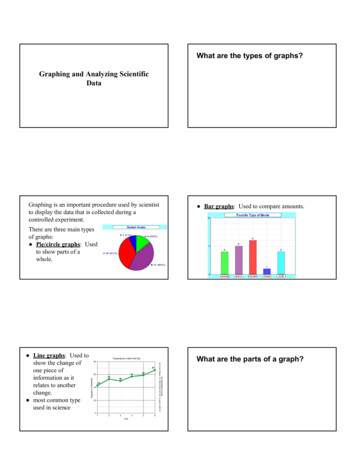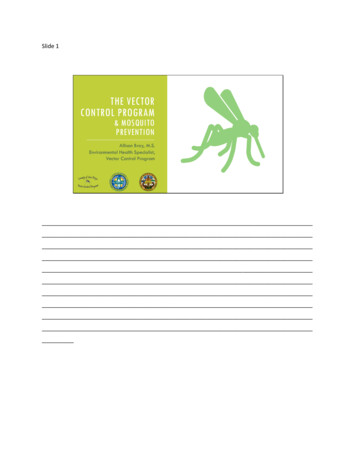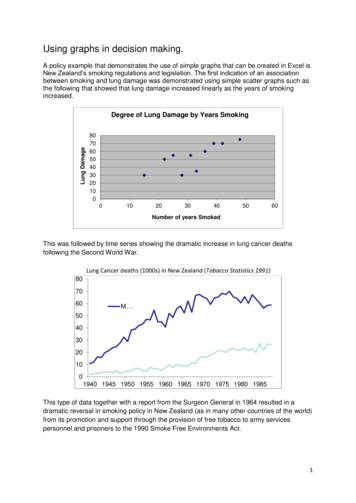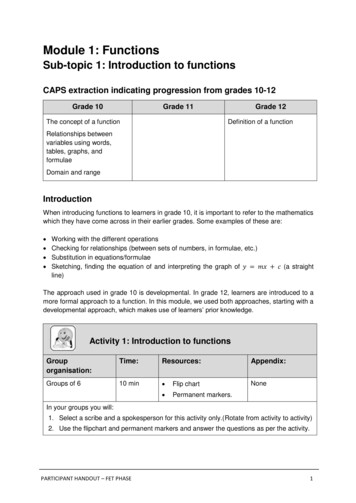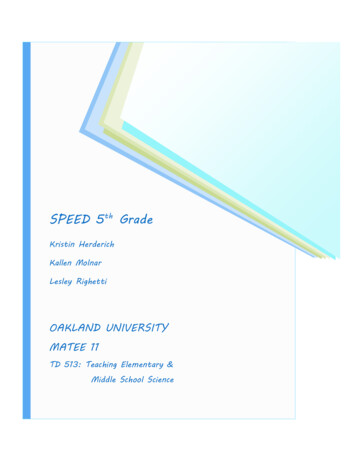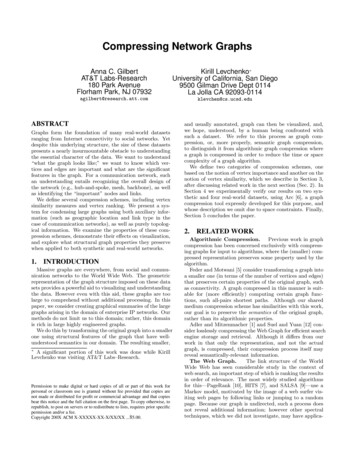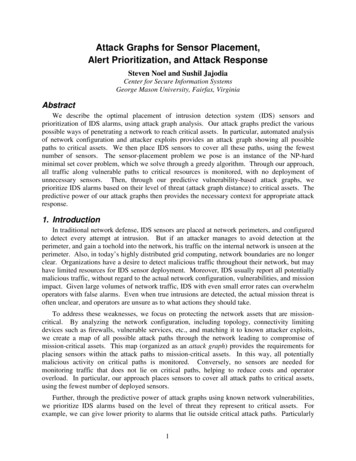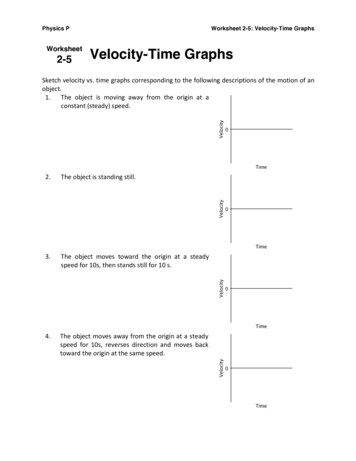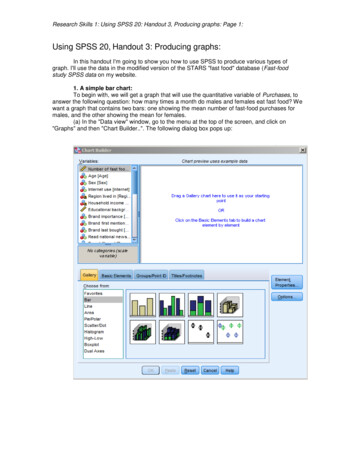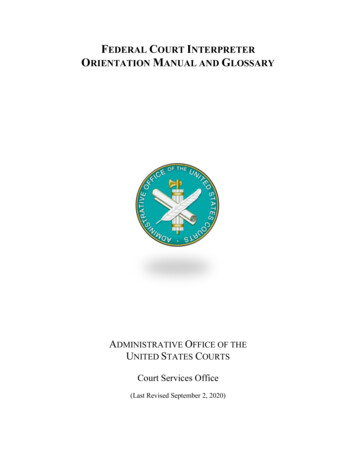
Transcription
Personal Knowledge Graphs: Use Cases in e-learning PlatformsEleni Ilkousupervised by Prof. Dr. Wolfgang Nejdlilkou@l3s.deL3S Research Center, Leibniz University HannoverHanover, GermanyABSTRACTPersonal Knowledge Graphs (PKGs) are introduced by the semantic web community as small-sized user-centric knowledge graphs(KGs). PKGs fill the gap of personalised representation of user dataand interests on the top of big, well-established encyclopedic KGs,such as DBpedia [21]. Inspired by the widely recent usage of PKGsin the medical domain to represent patient data, this PhD proposalaims to adopt a similar technique in the educational domain in elearning platforms by deploying PKGs to represent users and learners. We propose a novel PKG development that relies on ontologyand interlinks to Linked Open Data. Hence, adding the dimensionof personalisation and explainability in users’ featured data whilerespecting privacy. This research design is developed in two usecases: a collaborative search learning platform and an e-learningplatform. Our preliminary results show that e-learning platformscan get benefited from our approach by providing personalisedrecommendations and more user and group-specific data.CCS CONCEPTS Information systems Personalization; Collaborative search;Personalization; Applied computing Collaborative learning; E-learning; Distance learning; Computing methodologies Knowledge representation and reasoning.KEYWORDSe-learning, collaborative search, collaborative learning, personalised knowledge graphsACM Reference Format:Eleni Ilkou, supervised by Prof. Dr. Wolfgang Nejdl. 2022. Personal Knowledge Graphs: Use Cases in e-learning Platforms. In Companion Proceedings of the Web Conference 2022 (WWW ’22 Companion), April 25–29, 2022,Virtual Event, Lyon, France. ACM, New York, NY, USA, 5 pages. ONNowadays, societies focus on the digital transformation of education and skill development in online learning platforms [8]. MillionsPermission to make digital or hard copies of all or part of this work for personal orclassroom use is granted without fee provided that copies are not made or distributedfor profit or commercial advantage and that copies bear this notice and the full citationon the first page. Copyrights for components of this work owned by others than ACMmust be honored. Abstracting with credit is permitted. To copy otherwise, or republish,to post on servers or to redistribute to lists, requires prior specific permission and/or afee. Request permissions from permissions@acm.org.WWW ’22 Companion, April 25–29, 2022, Virtual Event, Lyon, France 2022 Association for Computing Machinery.ACM ISBN 978-1-4503-9130-6/22/04. . . 15.00https://doi.org/10.1145/3487553.3524196of learners use daily online learning platforms for their formal education, especially during the COVID-19 pandemic. The need foronline teaching and lifelong learning tools has gained momentum.The same happens with online collaborative learning and search.Collaborative search happens when two or more people team upin a search task online and perform synchronous or asynchronoussearches. Collaborative work online and collaborative learning aremore important than ever; however, platforms supporting webcollaboration lack semantic features, such as interconnections between the data and semantic recommendations. These platformsare mainly customised to facilitate learning applications and usuallyignore the description and documentation of modelled concepts. Asa result, current approaches cannot exploit common understandingencoded either in domain ontologies or knowledge graphs. At thesame time, there is an increased need for systems with high personalised capabilities, personalised collaborative search [5], and moreproductive and impactful platforms that can support collaborativelearning. Semantic web (SW) technologies can assist in this effort.Knowledge Graphs (KGs), although well-established and widelyused, such as the DBpedia and YAGO, do not directly contain personal information and are not usually designed to accommodateusers’ personal data. The same issue occurs also in domain KGs,such as in educational domain, where the need for personalisation issignificant [13]. The recently suggested personal knowledge graphs(PKGs) [22] come to fill this gap by offering pocket-sized knowledgegraphs related to users’ interests. The same issue also occures ineducational KGs where . PKGs in online learning environments canbenefit users by providing personalised features and connectingtheir actions on the web with KGs and Linked Data.The proposed line of work aims to assist the efforts of the SWcommunity in setting the standards of new applications with deploying further research in SW technologies, such as the PKGs, in noclassical computer science domains of application; in our case, theeducational domain and the collaborative learning and e-learningsub-domains. Also, based on our knowledge, this is the first attemptto utilise PKGs for purely educational and learning purposes andhave them developed in e-learning platforms. This work can assistresearchers in both fields of education and computer science tocreate better personalised systems, and encourage developers ine-learning platforms to utilise SW technologies. This proposal aimsto explore the syntax and semantics of PKGs in learning environments and increase the personalisation and explainability of thelearning system’s actions to users.2RESEARCH PROBLEMThe PhD thesis addresses the problem related to the personalisation of the web searches and to the enhancement of e-learningenvironments with personalised features linked to the SW. For
WWW ’22 Companion, April 25–29, 2022, Virtual Event, Lyon, Franceexample in e-learning platforms the importance of personalisedrecommendations is increasing; the PKGs could assist in this effortan e-learning platform which uses a knowledge base for its content. Also, collaborative searching environments and collaborativelearning usually offer features adopted from non-collaborative settings. Not many features are developed directly for collaborativelearning environments, which creates a gap between the needs ofcollaborative environments and the actual technology offered. Asolution could be the connection of the collaborative search withthe Linked Data. This can occur by utilising PKGs to connect individuals’ and group’s search with the semantic web and offer abetter collaborative and personalised experience.The thesis is formulated around the analysis of the characteristicsrelated to the deployment of PKGs for educational applications.However, we can especially classify our use cases in collaborativelearning environments and e-learning platforms. Therefore, weformulate the research questions of the thesis as follows: RQ1: How to syntactically and semantically represent a PKGin the e-learning domain? RQ2: How can e-learning platforms offer better semanticallyenhanced personalised features, such as semantic recommendations, with the usage of PKGs? RQ3: How can collaborative search learning environmentsoffer more personalised features with the usage of PKGs? RQ4: Can collaborative learning platforms offer better collaboration with the usage of PKGs?3 STATE OF THE ART3.1 Personal Knowledge GraphsPersonal or Personalised Knowledge Graphs (PKGs) are small graphson top of KGs which contain user’s related data. They are the natural complementary effort to address the challenges raised by thepersonal information management (PIM) [18], about users retrieving and organising personal information. PKGs are currently mostlyused in the medical domain, on top of medical KGs to representpatients data [26].In the broad domain, the works of Personalised KnowledgeGraph Summarization [9, 22] were introduced. The PKG summarisation constructs personal summaries of users from a KG that containthe relevant facts of the users’ interests. These summaries supportpersonalised content queries and utility. These works are linkedto KGs, such as the DBpedia and Yago, and provide the theoretical formulations for constructing PKG summaries from users’ pastqueries. Moreover, similar work to the PKG summaries directionsuggests graph-based approaches for users activity discovery fromheterogeneous personal information collections, such as emailsand files [23]. It proposes a method for unsupervised setting thatperceives privacy. Influenced by these works, we intend to createPKGs containing information about users’ and groups’ queries andactions while paying attention to privacy.3.2Personalisation in e-learningPersonalisation in e-Learning is about creating an adaptive environment for the learner with adaptive content that derives mainlyfrom the curriculum, educational resources, learning path, learningpreferences, and cognitive state. Then the personalisation usuallyEleni Ilkouhappens with a recommender system that suggests relevant contentto the user, in terms of content type and characteristics as well asprevious actions and performance of the user. The goal is to create user-centric applications that aim towards a positive learningexperience. There are different methods suggested for achievingpersonalisation in e-learning; KGs is one of them [13]. The twomain approaches are the symbolic, with the usage of ontologies, anda sub-symbolic approach, in which they handle recommender as ablack box. Also, the combination of the symbolic and sub-symbolicexists [12]; however, due to space limitation we will not extend inthis part.The symbolic approaches are deployed with the usage of ontologies and semantic frameworks. WASPEC [3] utilises a semanticframework that models learner profiles and categorises personalisation parameters to learning preferences and accessibility. Ourlatest publication, EduCOR ontology [11], contributes in that lineas it is analysed in Section 6. Another interesting approach is theformulation of the learning session graph to achieve personalisation in informal learning settings in information wikis [16]. Theirframework achieves high scores in recommendation relevance. Encouraged by their design and findings, we target integrating sessiongraphs in modelling user activity in the PKG.Another approach is a "black-box" educational recommendersystem can benefit from open learner models providing a bettersense of learning [1]. An open learner model assists students tounderstand their learning process and their peers. It can be classified as a cognitive tool approximating students’ abilities witha score similar to learning analytics dashboards. Abdi et al. [1]showed that open learner models could increase the explainability and transparency of a recommendation; however, there wereconcerns regarding the fairness and feedback of the recommendation. Their study suggests that users’ input and feedback intothe recommendation process can improve satisfaction. Motivatedby their findings, we aim to implement a transparent model inPKGs which justifies system actions and considers users’ input andfeedback in the recommendation process while offering additionalpersonalisation via semantic enrichment.3.3Collaborative Search and LearningCollaborative search can occur as a learning activity; Searchingas Learning (SaL) explores this direction and links collaborativesearch with collaborative learning. SaL in a collaborative settingis formulated around project-based or team-based scenarios [24].Research on understanding students online activity in SaL [17] suggests that the majority of students primarily choose content-basedweb pages, like Wikipedia, and that visualisations are essential,both for students and teachers who later can better monitor students’ behaviour. This finding supports our idea of implementingPKGs and semantic technologies in the collaborative search andlearning systems, and connecting the search with KGs and entities.Furthermore, different systems have been introduced in the literature for collaborative search. One of the newest advancements is theQueryTogether [2], a system for entity-centric collaborative searchin spontaneous settings that showed that entities could portray avital role as interactive search objects. Also, their study confirmedthat a common ground provided in collocated interaction supports
Personal Knowledge Graphs: Use Cases in e-learning PlatformsWWW ’22 Companion, April 25–29, 2022, Virtual Event, Lyon, Francedata with KGs to attain semantic relations between the data andidentify the most important entities of the collaboration.The proposed approach, in combination with a user-friendlyinterface and graphics, can help us reveal more personalised aswell as group-project needs and develop collaborative features thatare boosted with rich metadata and interconnections with the SW.Therefore, we would be able to examine how a collaborative elearning platform can benefit from the addition of PKGs in theirdatabase to offer advanced SW features, personalisation (RQ3), andbetter collaboration in general (RQ4). The potential applications wecan implement with the usage of PKGs include but are not limitedto better users’ credibility and understanding of the group’s activity,learning analytics, recommendations, and feedback.Figure 1: The overall architecture that includes the inputstream, intelligence computation and back end creation of apersonal knowledge graph (PKG).group awareness, which has a positive impact on collaboration.Inspired by their work, we plan to emphasise the entities in thegroup search and implement features that aid group participationand awareness. Moreover, the Learnweb platform had implementeda semantic-based approach the LogCanvas [27], a visualisation toollinking to KGs for collaborative search. However, although thesemantically enriched visual is a technically useful direction, theimplementation lacks a collaborative and user-friendly interfaceand design. We will enhance this work by understanding the pastpitfalls and designing collaborative semantic features linked to KGs.4PROPOSED APPROACHWe propose an architecture for the creation of a PKG for a userin the back end of an e-learning system in Figure 1 (RQ1). Theinput stream consists of the user’s generated data, which is thenpassed to the intelligence part. In combination with an ontology, theinput data are processed with the named entity recognition (NER)and natural language processing (NLP) software to identify theconcepts and entities from the KGs. Because user’s actions changethrough time, there is a weighted algorithm that recalculates themain points of interest for the user in each period of time. The blackbox calculates those weights and offers a filter in the recognisedentities from the KGs, which will be passed to the PKG. Then thePKG is created with respect to user’s and user group privacy. Byimplementing the PKGs as a structural element of a platform, weinterconnect the activities that happen in the platform with LinkedData and KGs. The research work in the creation of a PKG intends toaddress the questions related to syntax and semantics as structuralelements and regarding the represented data in each applicationcontext (RQ1).4.1Use case 1: Collaborative searchApplications using web search can get benefited by the usage ofPKGs, which can offer semantically enhanced features and personalisation capabilities. However, currently PKGs cannot play a rolein the filter bubble of the search results provided to the users. Wedevelop the collaborativesemantically enhanc search use case inthe e-learning platform Learnweb [20]. We link the input stream4.2Use case 2: e-LearningIn this use case, we utilise the knowledge base of the eDoer platform [19], an open learning recommendation system prototype thatconnects the labour market skills with open educational resources(OERs). The eDoer is currently focused on Data Science relatedskills; however, the research targets into system’s integration of aknowledge base in general domain OERs. The implementation ofour approach could allow users to receive personalised recommendations based on their learning preferences and needs, accessibilityneeds and access, and semantic-based solutions, such as relevantto their topics learning content (RQ2).4.3Opportunities and ChallengesOur proposed approach subsist on some novel items and opportunities. So far, the current problem has not been solved with theusage of PKGs. This research might increase the interest in integrating PKGs in other domains, as well as the influence of the usageof knowledge bases in the e-learning community to utilise publicly available KGs and PKGs in their applications. An opportunitystands in the exploration of better collaborative features via thePKGs. Besides the plethora of collaborative search systems, no collaborative search interface has received major attention and hasbecome long-established. This might happen due to the featuresoffered in collaborative systems being adopted from single userpurpose interfaces and are not directly developed for collaborativeenvironments [10].However, there are plenty of challenges this research needs totackle. At first, we need to face the puzzle of knowledge acquisition,entity recognition and linking, storage and maintenance of thePKGs and connection to external PKGs. We select to start our alphaversion by selecting DBpedia KG [21] and DBpedia Spotlight [6] tostore our data locally in the Learnweb platform and maintain thedata based on the processes provided by the Learnweb platform. Inthe future, we will focus on linking with more KGs and differentNER software to improve our computation time and increase ourcoverage of search topics into more domains and languages. However, if the platform becomes widely used by thousands of usersevery day, we will be forced to expand our local implementationinto a cloud service for computation and storage.Also, by deploying PKGs, we need to raise privacy as a first-classcitizen and ensure users’ consent to select data from the personal
WWW ’22 Companion, April 25–29, 2022, Virtual Event, Lyon, FranceEleni Ilkouprofile, store user actions, and share part of them with the collaborators to assist the collaboration and offer richer features. Also,the right to be forgotten based on General Data Protection Regulation [25] should be provided to the single user as well as the groupresults. We target to face this obstacle by keeping the users’ dataonly for a limited period of time, nonetheless long enough to servethe team’s objectives. Another vital factor to consider is that PKGsare highly time dependant [4]. Their information might change,particularly depending on the computation time, which affects theapplications offered based on PKGs back end. Overall, we aim toaddress this part by setting time constrains on PKG computationtime falls to ensure some level of confidence on the computed data.We discuss further challenges in future work.5METHODOLOGYThe methodology for approaching the research questions combinesqualitative and quantitative analysis. In order to understand howthe SW technologies are used in the e-learning domain, we planto conduct an interdisciplinary examination of the state-of-the-artsolutions relevant to our studied problems. This investigation includes the literature in the user profiling ontologies and schemes,literature in PKGs, and publications of solutions that apply personalisation in KGs and e-learning. Following, we aim to formaliseour research questions and hypotheses and define potential solutions while identifying the innovative contributions. The formalcharacteristics of the proposed approach will be demonstrated, andthe implemented solution will be made available to the communityconcerning users’ privacy.Mainly for evaluating our implementation, we will involve human participants in our research after receiving their consent basedon national and international privacy laws. A similar work toours [23], evaluated their method with requiting some participants(10 people). People with some technical background could performexperiments in the platform, which will allow us to collect andprocess their data and have their own experiences of the applications. We will develop documented in the form of interviews andquestionnaires, and perform qualitative analysis; it will measureusers’ experience and satisfaction of the implemented features. Experts and professionals might also be included in our studies toreceive precise feedback regarding the technical implementation,the learning aspects, and the user interface.Nonetheless, we are facing a limitation because there are no goldstandards and baseline metrics for evaluating collaborative searchand SaL. Among the different metrics that have been proposed arethe effects on users’ short and long term memory and gained knowledge, the time it takes to find information online and others. Severalbenchmarks have been suggested for a sub-domain of potential application tasks like the recommendations, such as the EdNet [7];but, they do not fit the nature of SaL activities, project-based andteam-based learning. However, we could compare our method withthe state-of-the-art recommendation software by adopting theminto a collaborative search learning environment.6RESULTSThe current line of research is still in an early stage. In our firststeps in user modelling in e-learning platforms, we have publishedFigure 2: User Profile pattern from EduCOR [11] ontology.Strongly disagreeSomewhat disagreeNeither agree or disagreeSomewhat agreeStrongly 612.383.8112.384.76EQ1EQ2EQ3EQ4EQ5Figure 3: User general feedback from CollabGraph [15]. EQ:"I like the" 1: the group results visualized in a graph, 2: thesummary of the team-members results, 3: the graph visualizations , 4: graph visualization next to the list view of thesearch results, 5: combination of the list and graph view.EduCOR ontology [11] for personalised recommendations of educational resources. EduCOR consists of different parts and has a focuson user profiling, as can be seen in Figure 2. This part of the overallontology has been extended in our latest submission to facilitatethe necessary components for the creation of PKG ontology forweb search [14] with respect to accessibility parameters, such ascontent access rights and privacy.
Personal Knowledge Graphs: Use Cases in e-learning PlatformsIn our latest paper, which is currently under submission [15], wedive into the collaborative search and propose a collaborative searchgraph summary visualisation alongside the classical list-view ofsearch results [15]. Our back end suggests the development of PKGsfor each user which capture users’ activity, connect to a KG in orderto identify concepts and entities, and propagate the top entities tobe visualised in the group summary graph. We evaluated our systemon six different learning scenarios among 105 valid participants in awell-established user experience questionnaire and some evaluationquestions we developed based on the parameters we wanted to rate.Our system shows high likability among users, as can be seen inFigure 3. However, it is still to be investigated how users perceiveour system in an on-site experiment, and how the implementationof PKGs is superior to a simpler approach with the extensions weforesee for our system.7CONCLUSIONS AND FUTURE WORKWe presented the research plan on personal knowledge graphs incollaborative search environments and e-learning platforms. Weoutlined our design based on the related work and discussed themethodology and proposed implementation in the two different usecases in e-learning domain. We argued that the proposed approachcould benefit collaborative learning search systems and e-learningplatforms which are connected to knowledge bases by connectingthem to semantic technologies, and we suggested a few applicationsto be deployed. However, there are is a broad domain of futureapplications such systems can develop.We believe this work opens a new line of research in web searchand PKGs. At first, this research can explore the knowledge acquisition processes as well as the mainting, creation and update factorsof PKGs.Further, privacy is a constant concern of personalised features. This issue could be addressed with a collaboration with legalresearchers. Moreover, editor’s and author’s data could align withthe data offered in the KG and provide the next generation KGswhich offer advanced content credibility, access rights and privacy.Additionally, this work could be further developed to offer semanticpersonalised recommendations. These could be related to furtherweb search items in collaborative search setting or suggested topicsand educational resources in e-learning platforms.From a general viewpoint, this research could be deployed towards the broader e-learning field and the human factors in computing systems or human-computer interaction. One case could bethe additional annotations and features to support learning, suchas direct feedback from the teacher in highlighted text and comments, and more user-centric visualisations. Another suggestionfrom the educational perspective could be the investigation of PKGsoutcomes in knowledge building spaces.ACKNOWLEDGEMENTSThe author would like to thank Prof. Dr. Maria-Esther Vidal for thefruitful discussion, guidance, and insightful comments. This workis funded by EU H2020 project KnowGraphs (GA no. 860801).REFERENCES[1] Solmaz Abdi, Hassan Khosravi, Shazia Sadiq, and Dragan Gasevic. 2020. Complementing educational recommender systems with open learner models. InProceedings of LAK’20.WWW ’22 Companion, April 25–29, 2022, Virtual Event, Lyon, France[2] Salvatore Andolina, Khalil Klouche, Tuukka Ruotsalo, Patrik Floréen, and GiulioJacucci. 2018. Querytogether: Enabling entity-centric exploration in multi-devicecollaborative search. Inf. Process. Manag. (2018).[3] Ufuoma Chima Apoki. 2021. The design of WASPEC: A fully personalised Moodlesystem using semantic web technologies. Computers (2021).[4] Krisztian Balog and Tom Kenter. 2019. Personal Knowledge Graphs: A ResearchAgenda. In Proceedings of the 2019 ACM SIGIR International Conference on Theoryof Information Retrieval, ICTIR 2019, Santa Clara, CA, USA, October 2-5, 2019.[5] Senthilkumar N. C. and Ch. Pradeep Reddy. 2019. Collaborative Search Enginefor Enhancing Personalized User Search Based on Domain Knowledge. J. MedicalSyst. (2019).[6] Mohamed Chabchoub, Michel Gagnon, and Amal Zouaq. 2018. FICLONE: Improving DBpedia Spotlight Using Named Entity Recognition and CollectiveDisambiguation. Open J. Semantic Web (2018).[7] Youngduck Choi, Youngnam Lee, Dongmin Shin, Junghyun Cho, Seoyon Park,Seewoo Lee, Jineon Baek, Chan Bae, Byungsoo Kim, and Jaewe Heo. 2020. EdNet:A Large-Scale Hierarchical Dataset in Education. In Artificial Intelligence inEducation - 21st International Conference, AIED 2020, Ifrane, Morocco, July 6-10,2020, Proceedings, Part II (Lecture Notes in Computer Science). Springer.[8] H Davies, V Lehdonvirta, A Margaryan, J Albert, and LR Larke. 2020. Developingand matching skills in the online platform economy: Findings on new forms ofdigital work and learning from Cedefop’s CrowdLearn study. (2020).[9] Lukas Faber, Tara Safavi, Davide Mottin, Emmanuel Müller, and Danai Koutra.2018. Adaptive Personalized Knowledge Graph Summarization. In Proceedings ofKDD Workshop on Mining and Learning with Graphs (MLG).[10] Marti A. Hearst. 2014. What’s Missing from Collaborative Search? Computer(2014).[11] Eleni Ilkou, Hasan Abu-Rasheed, MohammadReza Tavakoli, Sherzod Hakimov,Gábor Kismihók, Sören Auer, and Wolfgang Nejdl. 2021. EduCOR: An Educationaland Career-Oriented Recommendation Ontology. In The Semantic Web - ISWC2021 - 20th International Semantic Web Conference, ISWC 2021, Virtual Event,October 24-28, 2021, Proceedings (Lecture Notes in Computer Science). Springer.[12] Eleni Ilkou and Maria Koutraki. 2020. Symbolic Vs Sub-symbolic AI Methods:Friends or Enemies?. In CIKM (Workshops).[13] Eleni Ilkou and Beat Signer. 2020. A Technology-enhanced Smart LearningEnvironment based on the Combination of Knowledge Graphs and LearningPaths. In CSEDU (2). 461–468.[14] Eleni Ilkou, Davide Taibi, Marco Fisichella, and Tetiana Tolmachova. 2022. Personal Knowledge Graph Ontology for Web Search. (2022).[15] Eleni Ilkou, Tetiana Tolmachova, Marco Fisichella, and Davide Taibi. 2022. CollabGraph: A graph-based collaborative search summary visualisation. (2022).[16] Heba M Ismail, Boumediene Belkhouche, and Saad Harous. 2019. Framework forpersonalized content recommendations to support informal learning in massivelydiverse information Wikis. IEEE Access (2019).[17] Roope Jaakonmäki, Jan vom Brocke, Stefan Dietze, Hendrik Drachsler, AlbrechtFortenbacher, René Helbig, Michael Kickmeier-Rust, Ivana Marenzi, Angel Suarez,and Haeseon Yun. 2020. Understanding Students’ Online Behavior While TheySearch on the Internet: Searching as Learning. In Learning Analytics Cookbook.[18] William Jones. 2007. Personal Information Management. Annu. Rev. Inf. Sci.Technol. (2007).[19] TIB Labs. 2021. eDoer Education Portal. https://labs.tib.eu/edoer/[20] Learnweb. 2021. Learnweb - Learnweb. https://learnweb.l3s.uni-hannover.de/[21] Jens Lehmann, Robert Isele, Max Jakob, Anja Jentzsch, Dimitris Kontokostas,Pablo N. Mendes, Sebastian Hellmann, Mohamed Morsey, Patrick van Kleef,Sören Auer, and Christian Bizer. 2015. DBpedia - A large-scale, multilingualknowledge base extracted from Wikipedia. Semantic Web (2015).[22] Tara Safavi, Caleb Belth, Lukas Faber, Davide Mottin, Emmanuel Müller, andDanai Koutra. 2019. Personalized Knowledge Graph Summarization: From theCloud to Your Pocket. In 2019 IEEE International Conference on Data Mining,ICDM 2019, Beijing, China, November 8-11, 2019.[23] Tara Safavi, Adam Fourney, Robert Sim, Marcin Juraszek, Shane Williams, NedFriend, Danai Koutra, a
educational domain and the collaborative learning and e-learning sub-domains. Also, based on our knowledge, this is the first attempt to utilise PKGs for purely educational and learning purposes and have them developed in e-learning platforms. This work can assist researchers in both fields of education and computer science to
